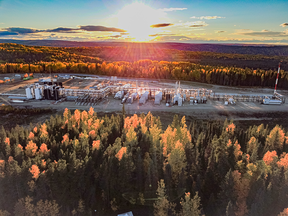
[ad_1]
Privately held Strathcona Resources, which has made its mark with a string of aggressive acquisitions in the past several years while other players were selling in Western Canada, has decided to chart a different path forward.
It will become a public company — the fifth-largest oil producer in the country — with bigger plans to keep growing.
Strathcona, which is owned by Calgary-based private equity firm Waterous Energy Fund (WEF), announced Tuesday an agreement to acquire junior producer Pipestone Energy Corp. in an all-stock transaction.
The share exchange ratio with Pipestone implies an initial market capitalization of Strathcona of about $8.6 billion. With $2.9 billion in debt, its enterprise value is expected to reach $11.5 billion, and it will be listed on the Toronto Stock Exchange.
“What we’re seeking to do is to build another Canadian oil and gas champion,” Adam Waterous, chief executive of WEF, said in an interview.
“We think that Strathcona now is of the scale that it will, as a Canadian champion, attract international investors.”
Under Tuesday’s agreement, Strathcona investors will own 91 per cent of the combined entity — which will continue as Strathcona Resources Ltd. — with Pipestone shareholders holding the remainder.
Once the deal is completed, likely in the fourth quarter, Strathcona will operate in three core areas: Cold Lake, the Lloydminster heavy oil region and in the Montney formation. It will become Canada’s six-largest petroleum producer by output, and fifth-largest oil producer.
The Calgary-based firm will have about 700 employees.
Waterous, who founded WEF in 2017, is also Strathcona’s executive chair. Rob Morgan will remain as Strathcona’s CEO and president.
The Pipestone deal marks the culmination of a string of aggressive moves by Strathcona.
In less than seven years, the company has expanded from 5,000 barrels of oil equivalent (boe) per day to 185,000 through acquisitions and organic growth, and Pipestone marks its 10th major acquisition, Waterous noted.
Last August, Strathcona made the largest corporate transaction of the year in the Canadian oilpatch, buying privately held heavy oil producer Serafina Energy for $2.3 billion.

Strathcona closed the amalgamation with Caltex Resources in March 2022, which produced about 13,000 bpd of heavy oil in Alberta and Saskatchewan, and snapped up the Tucker thermal oilsands asset from Cenovus Energy for $800 million in December 2021.
In 2020, it acquired Osum Oil Sands Corp, after buying Pengrowth Energy Corp. in 2019.
“Our investing thesis has been what we’d describe as a core area consolidation strategy,” Waterous said.
“The analogy that we like is that in real estate, when you find that attractive neighbourhood, you find a street you like, you buy a house, and then you buy up the block. That’s what we’ve been doing in building Strathcona.”
As a private firm and industry consolidator, Strathcona has pursued its aggressive growth plan even through the extreme lows and highs of oil prices during the past three years.
The Pipestone takeover takes place against the backdrop of a recent rally in oil markets, with U.S. crude prices closing Tuesday at $81.38 a barrel, down 43 cents. Yet, many public companies have been hesitant to aggressively spend money to boost production and incur the anger of investors who favour increased dividends and share buybacks.
With its large asset base, Strathcona believes it has the opportunity to organically boost output within eight years to 220,000 boe per day — and potentially up to 325,000, including through new greenfield projects — even without any future acquisitions.
“This is an unloved sector and an out-of-favour sector. Generally speaking, we think the public market has uninspiring values . . . Why go public then?” said Waterous.
“There are some targets that would make sense to combine with Strathcona that are more interested in taking shares in a publicly traded company as consideration.”
Pipestone itself has boosted its output from just 152 boe per day in the first quarter of 2019 to reach 35,000 boe a day this year, developing condensate-rich assets in the Montney formation in Alberta.

Through the deal, company investors will still get ongoing exposure to the sector, in “arguably one of the largest, probably most diversified upstream producers in Canada, in Strathcona,” said Dustin Hoffman, Pipestone’s interim CEO and chief operating officer.
“This new company has just got size, scale . . . and the ability to sustain long-term production growth. So it just made a lot of sense,” he said in an interview.
On Tuesday, shares in Pipestone fell 27 cents to close at $2.45.
Even with higher commodity prices, fund managers say they still want to see companies remain disciplined and focused on returning money to investors. And operating a public company is obviously much different — and comes with different expectations — than running a private firm.
“Sometimes, your best business decision isn’t what the market wants and, as a private company, you can shelter yourself from that. As a public company, you cannot,” said Rafi Tahmazian, a senior portfolio manager at Canoe Financial.
Recommended from Editorial
-

Strathcona to become fifth-largest Canadian oil producer after Pipestone takeover
-

Varcoe: Confident in oilsands growth, Waterous Energy Fund closes two deals
-

Varcoe: List of billion-dollar oilpatch ‘survivors’ grows as outlook stays strong
The call for a greater return of capital by producers isn’t fading away, added Eric Nuttall, a senior portfolio manager with Ninepoint Partners. While there is a need for more consolidation, he’s unsure if this is the start of a new wave of such M&A deal-making.
“It’s great to have a new oil-levered investment opportunity,” said Nuttall.
“I like (the) management. I like the strategy. I like that they were counter-cyclical and acquired meaningful exposure to medium and heavy oil with low declines. I think they have to pay down their debt.”
From his perceptive, Waterous said it makes sense to continue to grow its oil and gas output in Canada — and Strathcona is planning to do just that.
“We have an opportunity to substantially increase production, both organically and through additional acquisitions,” he said.
“And we think that large-scale oil and gas businesses, generally speaking, are healthy and they make for a stronger sector.”
Chris Varcoe is a Calgary Herald columnist.
[ad_2]
You can read more of the news on source
